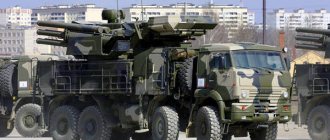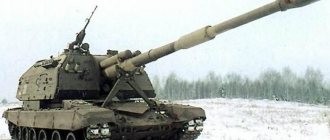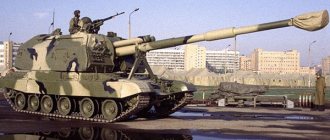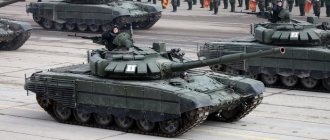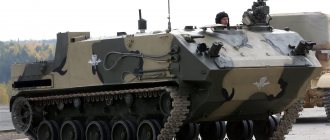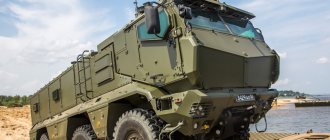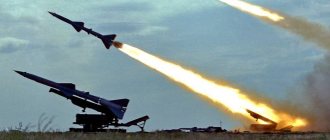Pantsir-S1 (at the development stage it was designated “Tunguska-3, GRAU index - 96K6, according to NATO codification - SA-22 Greyhound translated from English as “greyhound”) - a Russian self-propelled sea- and land-based air defense missile system.
History of creation
The development of mobile air defense systems for the Russian army is a priority task, taking into account the provisions and conditions of the military doctrine of the Russian Federation. First of all, this concerns the creation of a complex to counter drones, aircraft and ground vehicles.
A striking example of this approach was the development of the Pantsir-S1 missile and gun complex.
The development of air defense systems occurs simultaneously with changes in aviation. The ground forces had to respond to the creation of air vehicles of perfect design, and they began to develop means of countering powerful air attacks.
Given the improvement in the designs of helicopters and airplanes, the emergence of drones carrying ammunition and long-range cruise missiles, the threat to ground troops from the air has become especially acute in the 21st century. To cover strategic targets and ground units, the Russian army will use many mobile air defense systems, a prime example of which is the Pantsir-S1 air defense system. The history of its entry into service consists of several stages, which we will describe below.
- The first stage is the 70s. 20th century - the beginning of the development of Pantsir-S1, the capabilities of which would make it possible to successfully combine cannon and missile weapons. For this purpose, ground forces used mobile air defenses like anti-aircraft weapons. The stationary systems were armed with missile weapons, but they could not provide reliable cover for military equipment and personnel on the march. But thanks to the combination of guns and missiles, it was possible to increase the combat power of the complex and increase the versatility of the system. The complex was named "Tunguska". But, despite the arsenal of weapons from missiles and a thirty-millimeter cannon, the Pantsir-S1 air defense missile system could not fire missiles on the march, but only with visual contact with the enemy, which reduced the range of detection and destruction of the target.
- Mid 80's With the advent of cruise missiles, as well as weapons with high-precision electronic filling, the Tunguska complex could not provide reliable protection for equipment and troops. Army Tomahawk missiles hit Army units 60% of the time in theoretical strike simulations. As a result, the characteristics of the Pantsir-S1 air defense missile system with its low range, engagement height and target detection needed to be modernized. The Mechanical Engineering Design Bureau began improving the system taking into account the needs of the Soviet army.
- A new prototype called Tunguska-3 appeared in 1994. The complex was installed on a wheeled chassis of the BAZ or KamAZ variation to increase mobility and reduce the cost of the design. However, the Ministry of Defense was not interested in this system, since they considered the target destruction altitude of 10 km and the destruction range of 12 km to be insufficient for its launch into mass production and subsequent adoption. The complex was used only as an exhibition item at weapons exhibitions, and also as a promising example of future military equipment.
- 2002 - representatives of the UAE military department showed interest in the technology. But at the same time, they demanded that the system be improved. Based on the concluded contact, the UAE Army was supposed to receive 50 systems, but is allocating funds to modernize the system. Then all the main units and components of the complex underwent changes. Deliveries were completed in 2009.
- 2012 - The Pantsir-S1 air defense missile system was adopted by the Russian army. We signed a contract for the production and delivery of 38 systems to the army by 2016.
- 2016 – new modernization of “Pantsir-S2” from the Mechanical Engineering Design Bureau. It was supposed to replace the Tunguska short-range air defense systems.
The main differences between the characteristics of Pantsir-S1 and other complexes
The main differences of the Pantsir-1 air defense system are as follows:
- A combination of cannon and missile weapons. Foreign manufacturers divide air defense systems into anti-aircraft and missile systems (the former are being withdrawn from service because they are outdated). But modern conflicts in Iraq, Syria and Libya have proven the high effectiveness of cannon weapons in the fight against light air vehicles - UAVs; shooting down drones with a missile is too expensive and ineffective, and the use of a burst of several shells allows the complex to massively destroy such targets
- Standard lightweight chassis based on a tractor. It provides high speed movement on highways, as well as cross-country capability with troops on the march.
- The modular design of the chassis and complex allows you to install other weapons and retrofit the complex with additional modules. The scope for upgrading the system is quite large.
History of creation
The Pantsir-S1 air defense missile system was developed by a number of structures of the military-industrial complex of the USSR and Russia, headed by the Instrument Design Bureau.
In the 70s In the 20th century, the development of the Tunguska complex (predecessor of the Pantsir) began, the capabilities of which would make it possible to successfully combine cannon and missile weapons. However, the developers were unable to achieve the desired efficiency results.
A new prototype called Tunguska-3 appeared only in 1994. The complex was installed on a wheeled chassis of the KamAZ variation to increase mobility and reduce the cost of the design. However, the Ministry of Defense was not interested in this system, since they considered the target destruction height of 10 km and the destruction range of 12 km to be insufficient for its launch into mass production and subsequent adoption. The complex was used only as an exhibition item at weapons exhibitions, and also as a promising example of future military equipment.
In 2002, representatives of the UAE military department showed interest in the complex, but at the same time demanded to modify the air defense system.
In 2006, tests began at the Kapustin Yar test site of a modern model of the complex on a KamAZ chassis. Tests of the Pantsir-S1 air defense system took place during 2006-2007. at the Kapustin Yar and Ashuluk training grounds in the Astrakhan region.
On November 6, 2012, by order of the Chairman of the Government of the Russian Federation D. A. Medvedev, the Pantsir-S1 air defense system was adopted by the Russian Armed Forces.
Figure 3. ZRPK "Pantsir-S1"
The following structures were involved in the development and production of combat and training equipment of the Pantsir-S1 complex:
- The complex as a whole - State Unitary Enterprise "KBP", Tula, Tula region. (development)
- Onboard equipment of the complex - FSUE "NIIFP im. F.V. Lukina", Zelenograd, Moscow region. (development)
- Combat compartment - JSC AK Tulamashzavod named after. Ryabikova", Tula, Tula region. (production)
- Drives - State Unitary Enterprise "VNII "Signal", Kovrov, Vladimir region. (development); OJSC "PO" Plant named after. A.V. Ukhtomsky", Lyubertsy, Moscow region. (production)
- Target detection radar - JSC All-Russian Research Institute of Radio Engineering, Moscow (development)
- Target tracking radar - FSUE "Order of the Red Banner of Labor Research Institute of Radio", Moscow (development)
- Semiconductor microwave devices for radar equipment - JSC Svetlana Association, St. Petersburg, Leningrad region. (development/production)
Modifications
During development and operation, the characteristics of the Pantsir complex underwent significant changes.
- 1994 - creation and construction of the prototype Pantsir 1. The first product was made on the chassis of a standard army Ural.
- 2005 - after a ten-year break, a production model of the Pantsir-S1 air defense system was demonstrated with the designation ZPRK 96K6, the chassis of which was the KamAZ-6560. The production model had the following characteristics - two guns: 2A72 and eight 57E6E missiles, as well as an optical weapon control system. The export vehicle received the designation E. A characteristic feature is the foreign chassis MAN-SX45. The air defense system uses the SAM-9M311, taken from the Tunguska complex, as its main armament. Pantsir-S1 BM 72 - the complex is made with a BAZ chassis. The Arctic version of the system received the SA index. The DT-30 conveyor is used as a chassis. The ammunition consists of eighteen missiles. Essentially, Pantsir-SM is a modification of the complex with an improved detection and target tracking station. Detection range is 75 km, and destruction is up to 40 km.
Who wants to “drop” Pantsiri and why?
Similar methods were used by experts to underestimate the capabilities of our Pantsirs of various modifications, which allegedly cannot withstand Turkish drones in Libya.
Why did critics take up arms against this particular air defense system? The answer is contained in an interview with TASS dated January 29, 2022, by the chief designer of the Pantsir complex, Valery Slugin:
“Specialists of the Russian Aerospace Forces have a clear opinion that the Pantsir performed well in combat operations. This is actually the only complex in Russia that now has such experience of participating in hostilities.”
That is, it was the successful combat use of the Pantsir that caused a flurry of criticism from competitors. As they say, “nothing personal - just like in Chicago.”
© mod.gov.sy
The Pantsir air defense system has performed well in combat operations, including in Syria.
An analysis of unsubstantiated comments regarding the Pantsir air defense system revealed a standard set of criticisms that are used by our opponents. Let's figure out what we're talking about.
"Pantsir-S1" in service
Currently, Pantsir-S1 is in service with ten countries. The UAE Army has a stock of fifty installations that were supplied to them as part of the contact, starting in 2003. Alzhin also has an equally impressive stock of systems - 38 Pantsir-E units (the export kit cost $13.5 million).
As for Russia, there are fifty complexes of various modifications in service
Supplies are actively being carried out to the armies of Syria and Iran. Countries in Southeast Asia are interested in purchasing the system.
Lies have short legs
A clear historical example was once shown to us by the history of the confrontation between Soviet air defense and Israeli aviation in Egypt. In those almost historical times half a century ago for those living today, Egypt failed to competently use the Soviet air defense systems supplied to it, which led to the subsequent creation of the myth about the imperfection of Soviet air defenses, which supposedly did not pose any threat to Israeli fighters. It would seem that the Israeli media of that era were right - after all, the facts are clear: Egyptian air defense systems really did not know how to effectively repel air attacks. But in fact, the explanation did not lie at all in the performance characteristics of Soviet equipment, but only in the preparation and motivation of the crews serving them, consisting of local military personnel. And this was clearly demonstrated by the entire course of subsequent events.
Reference
In 1970, during the “War of Attrition”, at the request of the Egyptian leadership, the Soviet Union sent the 18th Air Defense Division (Special Purpose), entirely composed of Soviet soldiers and officers, to Egypt.
© Photo from the archive Anti-aircraft missile systems S-125 “Neva” in Egypt.
The formation was armed with S-125 Neva anti-aircraft missile systems. Israeli troops were in the Sinai Peninsula. The line of contact between the parties at war with each other ran along the Suez Canal. Israeli aviation completely controlled the so-called green zone along this waterway and did not allow Egyptian anti-aircraft missile systems to be placed in it.
Having understood the situation, Soviet generals and officers decided to use the tactics they had worked out at their “home” training grounds. Three anti-aircraft missile battalions lined up in a triangle on the ground. One of the divisions, under the cover of the other two, rolled up and moved forward to a previously scouted position. Under the cover of two others, he turned around and took up a fighting position. Then the second division collapsed and also moved in the same direction. Just like the first, he took up a new position under the cover of the other two. After this, the third division changed its location. This is how the Soviet military reached the “green zone” on the Egyptian bank of the Suez Canal. After deployment, the divisions were carefully camouflaged, and false positions with wooden mock-ups were set up nearby.
Reference
On August 3, 1970, a decisive battle took place between Soviet missilemen and Israeli pilots, during which 5 Israeli aircraft were hit. The Soviet divisions did not suffer any losses. After 3 days, Tel Aviv signed a truce with Cairo.
In fact, the competent actions of the command of the Soviet 18th Air Defense Division and the personnel of the divisions made it possible to stop the war between Egypt and Israel until October 1973.
As we see, in the case of attempts to slander the real and effective use of military equipment, the truth always reveals itself on the battlefield.
© Photo from the archive
The wreckage of an Israeli F-4 Phantom shot down by a missile.
Application of the Pantsir-S1 air defense missile system
The complex received combat use during the conflicts in Syria and Iraq.
Iraq. Used by the Iraqi army. As a result of the Islamist attack on Iraqi military forces in 2022 using drones, the Pantsir C1 complex was used. Of the eight targets, all were hit with cannon fire; there were no casualties among the Iraqi army.
Syria (Khmeimi airbase). The air defense missile system was used by the Syrian army and the Russian Aerospace Forces. The attack on the Syrian air base in 2022, where the Russian air forces were based, was carried out using drones that carried explosives; out of 80 air targets, 40 were destroyed by electronic warfare (EW), and 30 targets were suppressed by the Pantsir-S1 complex using missile and cannon weapons. The airbase did not receive any damage from the enemy.
Main tactical and technical characteristics of Pantsir-S1:
- Ammunition - 12 missiles, 1400 shells.
- Range – 20 km.
- The mass of the missile warhead is 20 kg.
- Deployment time is 5 minutes.
- Crew – 3 people.
- The number of tracked targets is 20.
- The maximum altitude for hitting targets is 15 km.
- Reaction time – 4-6 seconds.
- Detection range – 36 km.
- The height of the lesion is 15 km.
- The minimum height of the lesion is 5 m.
- Caliber – 30 mm.
- The range of cannon weapons is 4 km.
- The weight of the projectile is 840 grams.
- Barrel endurance is 8000 shots.
- Dispersion area – 2 square meters.
- Number of antennas – 3.
- Field of view – 2 modes.
- Pointing speed - 100 degrees per second.
Intentional technical libel
Unfortunately, there is another type of lie: this is an attempt at a scientific-like interpretation of performance characteristics on the part of the so-called repeater experts. There are a lot of military analysts in the world, but, unfortunately, not each of them is a real specialist in the issue that he treats in his materials and expert opinions.
One can understand such would-be specialists: they need to earn a living, orders come in an avalanche, and every time they need to analyze different types of military equipment from almost all developed (and not so developed) countries and different manufacturers. Therefore, today an analyst talks, for example, about nuclear submarines, and tomorrow about the Arctic, the day after tomorrow about space, and then about aviation... We have to, as they say, spin around, that is, use materials from experienced specialists and retell them. And there’s probably nothing wrong with that.
But it is through such would-be expert relays, who often do not have sufficient technical qualifications, that plausible lies are spread that discredit this or that technology. Such cunning lobbying is carried out quite subtly: often the author of one or another devastating statement about the alleged shortcomings of our technology does not understand that, in fact, he was taken advantage of quite cunningly.
“This cannot be, because it can never happen!”
Also a common technique among manipulators is a rude and, most importantly, unreasoned refutation of certain technical data. In the case of Pantsir-SM, our opponents have more than once expressed distrust of the fact that the air defense system is “capable of destroying vehicles flying at speeds of up to 3,000 m/s, as well as hitting ballistic targets.” Often on this occasion one can read the following “highly wise” conclusion: “This simply cannot be!”
In my opinion, this... position looks strange, to say the least. The fact is that the speed characteristics of the rocket, that is, those same 3,000 m/s, were declared by the developer himself. And their compliance with real combat characteristics will be assessed in state tests.
Meanwhile, according to information posted on the RIA Novosti website, the performance characteristics of the new Pantsir will be significantly superior to its modifications already being produced.
© mil.ru
"Pantsiri-SM" will be in two versions - missile (24 missiles per complex) and missile-gun (12 missiles per complex).
The RIA Novosti material, in particular, states: “Previously, there was information about a missile developing twice the speed of the standard 57E6E Pantsir-S1 ammunition - 3,000 meters per second versus 1,300.
The targeted firing range of air defense missile systems will increase to 40 kilometers, which is already comparable to medium-range anti-aircraft missile systems, and the target detection radius will increase from 36 to 75 kilometers. "Pantsiri-SM" will be in two versions - missile (24 missiles per complex) and missile-gun (12 missiles per complex). In addition, the possibility of installing a package of four small-sized anti-aircraft missiles in each launch cell to combat small targets such as UAVs, multiple launch rocket system shells, and mortar mines is being considered.”
I also note that the TASS website contains a publication about new equipment shown on June 24, 2022 at the parade in honor of the 75th anniversary of the Victory. In the material about (speed of Mach 5 or more. - TASS note).
Overview of the complex
Pantsir-S1 is a short-range anti-aircraft missile and gun system, placed on a tracked chassis, wheeled chassis of a truck, trailer, or permanently installed. Management is carried out by two or three operators. Air defense is carried out by automatic cannons and guided missiles with radio command guidance with IR and radar tracking (viewing angles 0-60° in elevation). The complex is designed to protect small objects from air attacks (both manned and unmanned). In addition, the complex is capable of combating lightly armored ground targets, as well as enemy personnel.
To ensure noise immunity, the communication system changes the frequency of 3500 hops/s according to a pseudo-random law over a wide range. The modular principle allows the system to be placed on any chassis, including tracked ones.
What is the Pantsir combat vehicle?
Structurally, the complex consists of a combat module, a control module and a power supply point. The system is self-sufficient from the point of view of conducting autonomous combat operations. The vehicle is operated by the troops by three crew members - the commander, the combat vehicle operator and the driver.
As standard, Pantsir S-1 is mounted on a KAMAZ mobile chassis. These are special chassis that are characterized by very high maneuverability and their load capacity is 37 tons.
The uniqueness of this air defense missile system is that it is a modular design that can be installed on any carrier. In particular, it was also produced on a tracked chassis. At one time, the issue of installing the complex on roofs was seriously discussed - in a stationary version, without a chassis, on the roofs of Moscow houses, in order to ensure the defense of Moscow. But, since the weight is large, and the roof slabs are not designed for this, the idea was not implemented.
Nevertheless, the complex can be installed on any stationary object. Currently, research and development work is underway to deploy the Pantsir on Navy ships.
This air defense missile system has a remarkable property that no other air defense system in the world has today - firing on the move. In the early 1990s, when the tactical and technical specifications for the combat vehicle were set, it was planned that it would be a stationary complex for stationary objects. But the KBP designers were able to implement a new quality that allows the Pantsir to accompany military columns.
For example, the famous S-300 air defense system on the move is not capable of defending against air attack weapons. “Pantsir S-1” can operate on the move, it goes next to the column, the locator rotates, detects the target in the event of an attack, shoots at it and provides cover. This has been confirmed by numerous experiments.
Performance characteristics
4.1 Main characteristics
- Type: ZRPK
- Crew, hours: 3
- Complex weight, kg: up to 30,000 (proportional to chassis)
- Deployment time, min: 8-9
- Reaction time, s: 4-6
- Ammunition: 1400 shells, 12 57E6-E missiles.
4.2 Detection system characteristics
- Radar stations: 1RS2, 1RS1-1E
- Type of radar stations: three-coordinate dual-band
- Antenna type: phased array antenna
- View azimuth (tracking/detection): (0 to 82)/45 degrees, thanks to mechanical rotation - 360
- Viewing Angle (Tracking/Detection): (0 to 82)/45 degrees
- Range (RCS 2 m²) (tracking/detection): 36/30 km
- Optical-electronic tracking system: available
- Field of view: 1.8 x 2.7 degrees
- Modes: manual/automatic
- Range, m: 18000.
4.3 Missile weapons (57E6-E)
- Type: supersonic two-stage solid propellant
- Guidance: radio command
- Speed, m/s (average at a distance of 18 km/maximum): 700/1300
- Maximum target speed: 1000 m/s
- Range to target, m: 1200 - 20000
- Target altitude, m: 15 – 1500
- Length. cm: 320
- Caliber: 170/90 mm
- Weight (with/without TPK), kg: 94/74.5
- Warhead type: rod
- Warhead weight, kg: 20
- Mass of explosives warhead. kg: 5.5.
4.4 Cannon armament (2A38M)
- Type: anti-aircraft twin machine gun
- Caliber, mm: 30
- Effective maximum firing range, m: 4000
- Total rate of fire: 5000 rounds/min
- Barrel survivability: less than 8000 shots
- Type of ammunition: armor-piercing incendiary
- Initial bullet speed, m/s: 960
- Cartridge weight, g: 842
- Projectile mass, g: 389.
Flaws
Speaking about the shortcomings of the military unit, it is necessary to mention that during testing the complex showed an extremely low ability to hit targets that are moving at a speed of two to three kilometers per hour. Due to the absence of a cruise-grade SAM engine, a missile launched from the complex may fly with some errors in aiming at an actively maneuvering target.
Separately, it should be noted the influence of weather conditions such as fog and rain on the systems’ ability to detect a complex of enemy targets. The large dimensions of the complex do not allow its use on the front part of the front or pre-battle formations of covered troops. In addition, the wheelbase suffers greatly from the exposed body.
Weapons on a wheeled base, again due to their own dimensions, cannot be transported by loading onto a train. However, it should be noted that opportunities for such actions exist. But for this you need to use a special tap. Loading by crane will take approximately 3 hours. Unloading will take about the same time. The last of the disadvantages can be considered the rather long time for loading full ammunition, which ranges from 25 to 30 minutes and in conditions of military operations can lead to undesirable consequences.
How the "Shell" was created
Photo: Anton Tushin
In the early 70s, under the leadership of Arkady Georgievich Shipunov, Department No. 4 was formed, which began developing anti-aircraft systems. The result of the work of this department was the creation of the Tunguska anti-aircraft gun and missile system for the ground forces, the Kashtan ship complex and the unparalleled Pantsir anti-aircraft missile and gun system, which today is the hallmark of the enterprise.
In an exclusive interview with the site, the chief anti-aircraft designer of the Tula Instrument Design Bureau, a student of Arkady Georgievich Shipunov, Valery Slugin spoke about the secret of the success of the design bureau, how the country's leading defense enterprise managed to survive the 90s, as well as the advantages of its developments.
Valery Georgievich Slugin, chief designer of the anti-aircraft design bureau, head of department 4. Born in the Plavsky district of the Tula region. Graduate of the Tula Polytechnic Institute.
When did you come to KBP?
I came to the Instrument Engineering Design Bureau in 1971 to defend my diploma. I studied at the Tula Polytechnic Institute in a specialty with the beautiful name “electrical equipment of aircraft.”
Before getting into the thematic department, I had to go through all the steps, and this is very correct. I worked for about five years in an industry division, where they directly create drawings, draw diagrams, and produce electronic components. I was just working on electronic components. The first head of the division was the famous designer Rudolf Janovich Purzen.
Rudolf Yanovich Purzen (1920-1997) - designer, one of the creators of the ZU-23 twin anti-aircraft gun and the 14.5-mm anti-aircraft mountain-pack mount, took part in the development of a light mount for the Utes machine gun, and Konkurs anti-tank missile systems and “Fagot”, anti-aircraft missile and gun complex “Tunguska”.
As a matter of fact, I came to him practically for the state tests of the Konkurs anti-tank missile system. Later he took part in the development and testing of components and the complex itself. I had to work a lot with Vasily Petrovich Tikhonov, who was the chief designer of the Konkurs projectile, who later invited me to join him to work on a new projectile.
The Konkurs complex is adapted for landing on parachute landing platforms. When carriers overcome water obstacles, shooting afloat is ensured. The complex consists of a combat vehicle with a liftable launcher for five missiles placed on it. In 1974, the “Competition” was adopted for service. The car took part in the parade on Red Square. “She was the first in technology,” Slugin noted proudly.
At this time, within the 4th division, a thematic department was formed for “maritime affairs”, in particular for “Kashtan” (export version of “Kashtan”). And Arkady Georgievich Shipunov supported the proposal of Rudolf Yanovich Purzen to leave me in the fourth division and transfer me to anti-aircraft matters. That’s how I got to the topic of “Kortik” (a ship’s anti-aircraft missile and artillery system). The project started from scratch. As the designers say, to the first center line, which meant starting work from the moment the first center line is drawn on paper, from which the creation of the part begins.
I had no experience of working at sea. Then I had to travel to shipbuilders, since the development was tied directly to ships.
What was the impetus for the creation of the Kashtan complex?
The impetus for the creation of the Kashtan air defense missile system was the events in the Falkland Islands, when they began to fight ships with cruise missiles flying extremely low over the water - the Argentines sank the British destroyer Sheffield with an Exocet missile. The task was set to create equipment capable of hitting low-flying targets.
Before starting work on the Kashtan, KBP, together with the Kharkov Institute, studied the accuracy of target tracking in the millimeter range.
Shipunov’s insight played a role here, on whose initiative we independently investigated the issue of the appearance of the locator. However, all our developments had to be given to a third-party company, since the location was not part of our immediate area of expertise.
But, nevertheless, the result of joint efforts was the creation of a radar system operating in the millimeter range. This is one of the features of our complex. Such waves are preferable when tracking a target over the sea. This was not the case in Tunguska. By the way, only the rocket was borrowed and modified from Tunguska. Unlike the Tunguska, which worked on targets only in clear weather, the Kashtan was created as an all-weather complex. For the first time, they made a pure automatic machine - the complex can operate without human intervention in both optical and radar modes.
All other elements of the Kashtan - the missile, launcher, optical system, cannon armament - were developed at the KBP.
While working on Kashtan, we gained important experience in interacting with subcontractors, which turned out to be extremely valuable in the future. Working in such complex cooperation required a precision approach, so that not a single link was weak, so that all work, including related projects, met the required specifications and was completed on time.
The chief designer of the complex was Arkady Georgievich Shipunov. He had this characteristic - he never took on faith what was asked, even if it was about the Ministry of Defense. He himself analyzed what type of weapons were needed in a particular direction and how it would develop. Will serial products be in demand in the future, will serial factories produce these products, will they be profitable?
But I must say what was missing. We did the development and sent it to another plant. This, of course, was completely wrong. KB did not receive any dividends from this.
In the 90s, after the collapse of the Soviet system, many design bureaus ceased to exist. How did KBP survive?
KBP has survived due to its versatility. Then we had about 5 directions, in each of which a whole range of work was carried out, in each direction there were high achievements. A.G. Shipunov: “To create, a person must be free, he must not be hindered in his work, and he must not think about his daily bread. And the erection of all sorts of barriers, the narrow specialization of enterprises, which was also the case under Soviet rule, led to serious losses not only of new strategic developments, but also of elite personnel potential.”
In addition, when the state stopped patronizing the designers, A.G. Shipunov, earlier than others, realized that it was necessary to make products and sell them independently, including abroad.
A.G. Shipunov: “In the 90s we chose our destiny. Of course, one could have acted differently, defining the path of the beggar, which would not lead to success in the market conditions. Therefore, a concept was developed at KBP. This is a triad. The first is science, as a producing force of new ideas and technology that will be in demand. The second is the production of this equipment, for which JSC Shcheglovsky Val was created and the capacity of the main production of KBP was expanded. The third is implementation.”
The transition to mass production of products, which Shipunov organized, was a very important point. We started with small arms for the Ministry of Internal Affairs, naturally, in cooperation.
The second important task at that stage was the need to earn money. Then an analysis of competitive markets was made, which showed that our products are quite competitive. The state met us halfway in this regard - some enterprises were given the right to foreign economic activity in the arms market. And this was the next stage in the development of the enterprise. They consistently fired from all directions - ATGMs, cannon shells, anti-aircraft and almost all small arms and cannon weapons. We entered the markets of India, China, the Middle East, and some Western countries. In particular, the West was interested in “Krasnopol”, but was unable to create a worthy analogue.
The Kashtan complex, for example, is exported to India and China. The specificity of marine systems is that the need for them is determined by the number of ships on which they are installed. Large countries build ships. In addition, not many ships are being built; only about forty were made. For example, our Russian aircraft carrier has eight combat modules installed. If we are talking about a cruiser, then these are 4-6 modules. Compensation comes from price. The price of offshore complexes is twice as high as onshore ones, which is due to more complex maintenance and service. For example, the naval version of the Pantsir, Pantsir-M, which we are actively working on now, will be at least twice as high.
When did you switch to land topics?
I switched to land topics after the state tests of the Kashtan, during which I had the opportunity to make the final launch.
The appointment as head of the department was decided when I was completing work on “Chestnut”. Since January 1987, we began to deal with land technology. We had the Tunguska-M2, then we had an air defense missile system for paratroopers, but, unfortunately, these topics did not take off. When funding sharply decreased, these topics were closed. But we would not have pulled them in any case, because these vehicles were assigned to us on tracked chassis. And this was an eternal dispute between the chassis engineers and those who make weapons, who is more important. The chassis is quite expensive. And we did not finance the work at our own expense in this form.
Then Shipunov gave priority not to the Tunguska-M2, because he believed that there would be no global wars and, above all, mobile troops, airborne troops, would be developed. And the new complex was created just as an option that can be dropped by parachute. Troops must be protected from the air, because the same helicopter can hit airborne combat vehicles, infantry, and tanks. Therefore, it is necessary to have an anti-aircraft weapon. Shipunov clearly understood this. However, unfortunately, the development turned out to be unclaimed.
When did work on Pantsir begin?
The idea of creating the Pantsir complex appeared along with the awareness of the need to protect the most important objects on earth. Already today wars are non-contact. ...Take the same Libya, Yugoslavia... According to our information, about 100-120 “tomahawks” were launched at Libya.
Then this idea was just emerging, but now it has come to the conclusion that about 250-300 “tomahawks” fired in the shortest possible time with a long range from somewhere in the Atlantic can independently travel 2.5 thousand km.
Now there is an active development of air attack weapons. "Tomahawks" are already becoming obsolete. They are being replaced by hypersonic aircraft, which fly higher and the air does not interfere. The speeds are tens of times greater than those of the same “tomahawks” - a low-speed “tomahawk” is about 250 meters per second, and with hypersonic we are talking about a speed of about 1500 meters per second.
What are the advantages of Pantsir?
"Pantsir" is developing ahead of the means of developing air attack. Now work is underway on the next generation of Pantsirs, which take into account various means of air attack.
We supply the customer with a weapon system that includes up to six combat vehicles, united by a control center. Three such points can create an air defense system for an entire country
Valery Slugin, chief designer of KBP on anti-aircraft topics
We have three types of communications: radio communications, fiber optics, and wires. The complex has radar protection. The complex is direction-finding, so you need to work in such modes as to significantly complicate direction-finding and deceive the enemy. The most important thing is that we have a millimeter range, for which homing projectiles have not yet been developed; development on them is just underway. It is very difficult to fight this range. It is impossible to interfere with him. “Shell” can be used alone, but it is better when it comes to a division. Each machine can work on four targets simultaneously, respectively, if we are talking about four machines, then it becomes possible to hit 16 targets. On the basis of Pantsir, it is possible to build the entire air defense system of a small country without attracting large funds.
Another highlight of Pantsir is the rocket.
Since the time of Tunguska (80s), the concept of developing anti-aircraft weapons in the near zone has changed. It seemed to many that it would be more logical to create a “smart” missile that itself would find a target and shoot it down. We went a different route. We removed all the unnecessary stuff from the rocket, making it as simple and fast as possible. The guidance head is not on the rocket itself, but on the ground, where more complex algorithms can be invented. As a result, we received very inexpensive ammunition. This is a fundamentally important point, given the way air attack weapons are developing. Their cost decreases. For example, the same drone can also fly up and drop something, take a photo, and take down information. What about the “tomahawk”? All this needs to be knocked down, but with what? S-300 or S-400? What is their price?
Another advantage of the Pantsir is mobility. Need to go to Kamchatka, flew to Kamchatka.
In what directions is the Pantsir modernization going?
The directions are still the same: increasing the speed of achieving goals, accordingly you need to respond with the speed of the rocket, including, you need to see the target further, otherwise you will not have time to shoot. At the same time, it is necessary to maintain and even increase accuracy. And you still need to manage not to leave your price niche and weight-dimensional characteristics.
Recently we began to create control points in case we are talking about a group of “Shells”.
KBP had never made control points before. It was my initiative. And the development turned out to be in demand on the market, including foreign ones.
The control point can be located at a distance of 20 km.
Moreover, each individual machine can, albeit to a limited extent, perform the functions of a control center.
What are you working on now?
We went in such a way that the chassis element did not bind us.
Now Pantsir is minimally integrated with the truck. For example, we supply the complex on the MAN chassis to the Emirates.
We are promoting our chassis to the market. In this regard, we have a dream - KAMAZ and I are making a chassis no worse than Manov’s, which involves greater integration into this chassis. We place people in the cabin so as not to make a special compartment for them, so as not to create extra weight. We hope that KAMAZ will develop such a chassis, and we will sell the complex on our domestic chassis both within the country and abroad.
Now KBP is working on creating a new generation “Pantsir”.
Are there any analogues of Pantsir abroad?
There are no similar developments in the world! There are good developments. French "Crotal", for example. But they did not develop it further. The French immediately focused on homing heads - “Aster-15/30” and entered a different price category. There is an Israeli tactical missile defense system called the Iron Dome, but it also has a homing head. Although they show fairly reasonable prices, I don’t believe them, I think they are much higher.
Who do you consider your main competitor?
I consider the American Patriot air defense system my competitor. An excellent system, but it has a different range. Among the domestic systems - "Buk". It's a well-connected system, but the execution is on tracks and lacks finesse.
How long is the Pantsir designed for service?
“Pantsir” should serve for 25 years. Naturally with certain restoration repairs.
How is maintenance carried out on exported Pantsirs?
This is a very serious matter. We are talking about an entire industry.
We supply a lot of spare parts. But we supply them for 4-5 years. During this period, the complex can be in combat readiness using our spare parts. Now, if a block fails, it is replaced. What if one microcircuit in the unit fails? Sending it to Russia for repairs is very expensive and impractical. This is roughly how it is done now. Of course, you need a service center. Only things that cannot be repaired locally should be sent to Russia.
The creation of service centers is planned, but the process is proceeding very timidly. And this greatly impacts military-technical cooperation.
What role did A.G. Shipunov play in your destiny?
I had the opportunity to work with a brilliant person and do something together. We consulted with A.G. Shipunov until very recently. In any circumstances, communication was not lost; he always helped with advice. I consider Arkady Shipunov my teacher.
What impressed and motivated you?
The most vivid impressions are associated with professional activities - when you see a flash and the fall of a target.
"Pantsir-S1" is a universal anti-aircraft system for all branches of the military, providing protection of defense facilities from all types of modern and future air attack weapons - high-precision weapons and aircraft at a distance of up to 20 km and throughout the entire altitude range of their use. “Pantsir” has a special role in protecting the Olympic venues and the country’s Arctic borders. “Pantsir” stands on a par with promising models of highly intelligent weapons of the new time.
Tula Instrument Engineering Design Bureau is one of the leading design and engineering enterprises in the defense industry. Since 2008, it has been part of the Rostec holding company “High-Precision Complexes”. Design bureau specialists have developed and mass-produced more than 150 pieces of military equipment. KBP has powerful research and production potential in the field of creating modern high-precision weapon systems.
Combat characteristics
The S-1 is armed with an ammunition load of 12 warheads. The affected area ranges from 12 to 20 kilometers. The combat crew of the vehicle is 3 people. The complex is equipped with a 1RS1 detection and target designation station, as well as a target and missile tracking station. In addition, some factors should be noted regarding the 57E6-E anti-aircraft guided missile.
- The mass of this weapon is 94 kg.
- The caliber is 170 mm.
- The length of the rocket is 3160 mm, while the speed developed by the rocket is 1300 meters per second.
In addition, on the Pantsir-S1 base there are two 30 mm double-barreled assault rifles.
